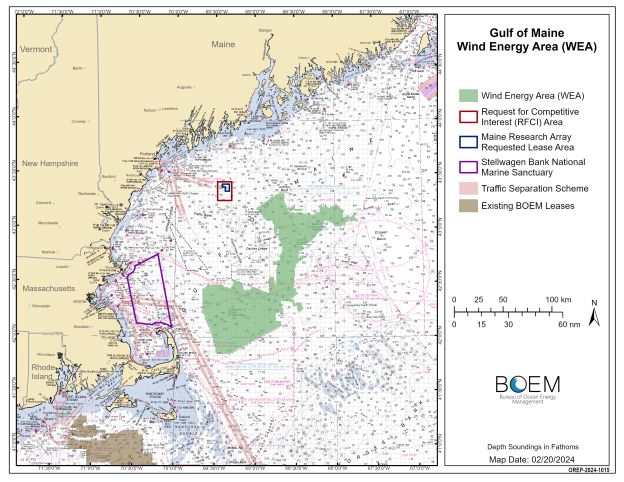The U.S. Bureau of Ocean Energy Management ("BOEM")
recently announced the finalization of a Wind Energy Area
("WEA") in the Gulf of Maine. According to BOEM's press release, the Final WEA
"has the potential to support generation of 32 GW of clean
energy, surpassing current state goals for offshore wind energy in
the Gulf of Maine: 10 GW for Massachusetts and 3 GW for
Maine."
The finalization of the WEA represents a critical next step in the
multi-year BOEM process to identify areas in
the Gulf of Maine suitable for the development of offshore wind
energy. BOEM indicates that, because the Final WEA
surpasses current state goals for offshore wind in the Gulf of
Maine, the larger area will allow them to "consider additional
deconfliction, while also supporting the region's renewable
energy goals and the potential for multiple lease sales, as BOEM
continues to evaluate a phased leasing approach."

The 2-million-acre Final WEA features water depths ranging from
450 to 800 feet. These depths are considerably greater than those
where fixed-foundation offshore wind turbines are commonly
deployed, indicating a high likelihood that floating offshore wind
turbine technology will be featured in future commercial
developments in the Final WEA.
The likelihood of floating technology deployment in the Gulf of
Maine is further strengthened by the potential that BOEM could provide floating
offshore wind-specific bidding credits in future lease sales,
representing up to 25% of a total bid. Bidding credits have been
used in recent lease sales to facilitate the development of the
domestic offshore wind supply chain and workforce training and to
provide compensation to mitigate potential impacts.
The Final WEA ranges from ~20-90 miles off the coasts of Maine, New
Hampshire, and Massachusetts. The total size of the Final WEA is
approximately 40% smaller than the Draft WEA announced in October 2023. BOEM said it
received more than 300 public comments on the Draft WEA and that
the Final WEA "avoids important areas for lobster fishing,
North Atlantic right whale habitat, and other important fishing
areas and habitats. Additionally, in response to initial
conversations with Tribal Nations located within Maine, the WEA
strives to avoid a majority of the historical and present-day
fishing grounds of those Tribes."
As a next step, BOEM will publish an announcement in the Federal
Register stating its intent to prepare an environmental assessment
of potential leasing activities in the Final WEA. The announcement
will also open a 30-day public comment window.
BOEM Director Elizabeth Klein said BOEM "is committed to
maintaining strong collaboration with the states of Maine,
Massachusetts, and New Hampshire" and remains "dedicated
to engaging with Tribal governments, federal and state agencies,
ocean stakeholders, coastal communities, and all interested parties
as we progress through our environmental review."
We'll continue to monitor offshore wind activity in the Gulf of
Maine.
The content of this article is intended to provide a general guide to the subject matter. Specialist advice should be sought about your specific circumstances.

